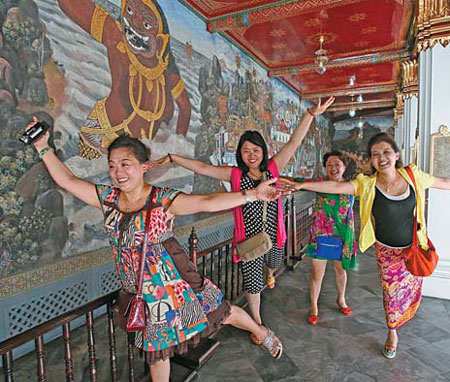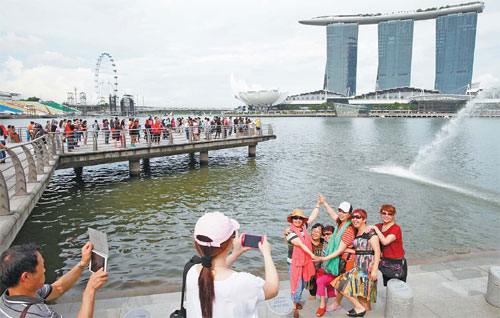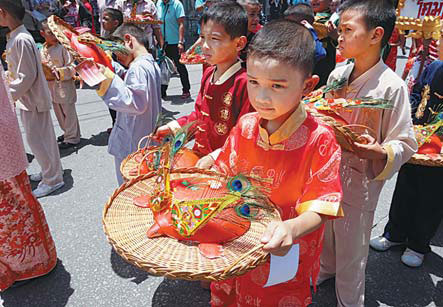Destination desolation
Updated: 2014-10-04 08:11
By Erik Nilsson(China Daily)
|
||||||||
Southeast Asian countries continue to lure Chinese tourists. But fewer are answering their call. Erik Nilsson reports.
The relative decline of Chinese tourists to Southeast Asia is to an extent a story of paradise lost - but is perhaps more so a testament to new paradises found.
Outbound Chinese travel to the region has plummeted this year by nearly 40 percent in Singapore's case.
Discussion surrounding the startling drop - the Association of Southeast Asian Nations' five-year tourism development plan is aimed toward Chinese and Indian visitor influxes - has largely honed in on a new, perceived undesirability of old favorite destinations.
Media point to territorial disputes with the Philippines and Vietnam; the disappearance of flight MH370; Thailand's instability; and Singapore losing influence as a gateway to aforementioned destinations.
That's all true.

But insiders explain the bigger picture is the otherwise changing dynamics of China's outbound tourism.
The United Nations World Travel Organization's Asia-Pacific director Xu Jing calls the widely reported view of a decline of Chinese tourists to the region a "misconception".
"There's a slowing of growth rates to some destinations," he says.
"But if you're talking about sheer volume, it remains large. Southeast Asia is still a big slice of the cake. It's still a very attractive destination. Take the natural beauty with the cultural component of travel Southeast Asia will remain a major destination for Chinese."
Xu believes the relative reduction is more about the outbound Chinese market's maturation and new countries better courting it.
"The changing behavior of Chinese travelers is the result of the previous 10 years of travel experience," he says.
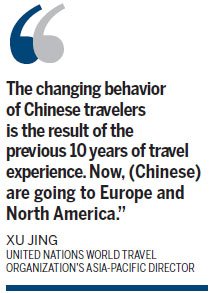
Many took their first international trips in Southeast Asia and now seek something new, Xu says.
And more countries better realize Chinese have been the world's biggest spenders on international tourism in the past five - and especially the past two - years, he says.
"Now, (Chinese) are going to Europe and North America."
Xu points to Maldives as an example of a country that early on devised savvy for courting Chinese.
"Nobody would've guessed Maldives would become (a major) beach tourism destination for Chinese 10 years ago," he says.
"It all depends on how you market to the Chinese. Maldives has made great efforts to effectively penetrate the Chinese market."
Southeastasiatrip.com product manager Peggy Lyu explains: "The impact (on Southeast Asia) can be interpreted as a relative growth of Chinese traveling to other countries. Take South Korea and America, for instance, bringing in more (Chinese currency) to their shops, hotels and restaurants."
South Korea has emerged as Chinese tourists' No 1 international destination as Southeast Asian visits decline, with Japan as a close second, following a 2012 dip due to sour relations.
China accounts for about 40 percent of Korea's inbound tourists, compared to 23 percent two years ago, Hong Kong Polytechnic University's tourism professor Brian King says.
"The relativities are important," King says.
"The air-seat capacity from China into Northeast Asia, including Macao, Taiwan and Hong Kong, is about three times the size of its equivalent into Southeast Asia. Korea is probably the main beneficiary and has been experiencing consistently high growth out of China."
Institute for Tourism Studies researcher Jae Yeon Choe says: "While preferences for easiness of visa procedures and air service expansion - such as nonstop flights - are factors, Korea's and Japan's pop, fashion and food culture continue to attract Chinese visitors."
IT developer Cheng Wei says his parents wouldn't "let" him visit Vietnam over the National Day holidays.
But he enjoyed Korea two weeks before on his first international trip.
"Korea is nearer than Vietnam," the Beijinger says.
"Flights are cheaper, and it's more developed."
Singapore is the most developed Southeast Asian destination to suffer from the tapering off of Chinese visitors. But industry insiders say that has more to do with Chinese policy than Singapore's positioning as a gateway to other destinations.
"With China exercising closer scrutiny on official government junkets and corruption, Singapore has lost some attraction," Choe explains.
"Gambling was a big draw."
King says Southeast Asian countries have "adopted separate approaches" to deal with the drop.
"Singapore has presented itself in China as a single standalone destination as a means of distinguishing itself from the trouble occurring in neighboring Malaysia," he says.
Chinese tourism to Malaysia dropped 9 percent to 850,877 between January and June compared with the same period of 2013, following years of growth, Tourism Malaysia's general director Dato' Mirza Mohammad Taiyab says.
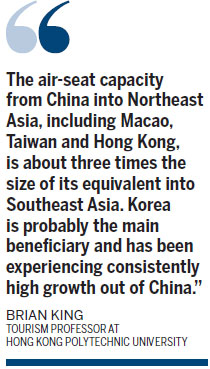
He believes the dip to be temporary.
Malaysia has responded by studying Chinese travel preferences according to regions and is tailoring marketing according to specific locations, he explains. It's also staging social media campaigns focused on safety; introducing new products and packages; developing charter flights; and marketing more toward second- and third-tier cities.
"Malaysia's priority is to regain the goodwill and friendship of the Chinese people," Taiyab says.
"We are confident that the tourist flow from China will return to normal soon."
King says Thailand has been "particularly active" in courting Chinese tourists.
"(It's) waiving visa fees; launching special retail offers; partnering with Chinese travel agents to develop appealing packages; lessening import duties on luxuries; and stimulating flights to airports away from Bangkok.
Indonesia has started a Chinese-language website."Indonesia has emerged as the region's main beneficiary of neighboring countries' decline.
Outbound tourism to the country grew 22 percent in the first half of the year, King says.
Lyu points out the archipelago proactively courts Chinese tourists.
"Direct flight routes between major Chinese cities and Bali, plus a visa-free policy, win them a handful of bills. More resources and money are being spent on advertising, upgrading facilities, training Chinese-speaking guides and trade shows."
The tourism authorities, embassies and comparable bodies of Thailand, Singapore, Vietnam and the Philippines didn't respond to repeated China Daily interview requests.
The Philippines' acting cultural attache in Shanghai, Gerard Panga, explains by e-mail: "We are assessing the situation, with high hopes that everything will normalize at the soonest possible time."
Panga adds a media statement will be released afterward.
Allan Lieberman, who owns the Spider House Resort in the Philippine's Boracay, says he hasn't perceived a decline in Chinese tourists. Instead, he has noticed two new Chinese cruise ships docking on the beach a month.
The Canadian sent his son and daughter to study Chinese in Beijing and aspires to open a Chinese-language school on the island to cater to the throngs who, including the mainland, Taiwan and Hong Kong, comprise the plurality of visitors, he says.
"I've discussed (the school) with other resort owners, and they see it as a necessity," he says.
Xu points out that while many Chinese are seeking new regions after experiencing their first international excursions in Southeast Asia, many are returning.
"They're revisiting the same Southeast Asian locations," he says.
"Before, it was from a sightseeing perspective. Now, they're on their second visits, going deeper into the cultures."
Contact the writer at erik_nilsson@chinadaily.com.cn
|
A Thai food festival in Bangkok in July attracts a huge audience. Gao Jianjun / Xinhua |
|
Chineseturists visit the Grand Palace in Bangkok in May. Reuters |
|
Chinese tourists pose for photos with the Marina Bay Sands casino and hotel in the central business district of Singapore in May. Reuters |
|
Angkor Wat in Cambodia is the largest religious monument in the world. Provided to China Daily |
|
Boys hold turtle-shaped pastries for worship in Phuket, Thailand. Xinhua |
|
A tourist in a traditional Korean attire poses in front of a painting. Xinhua |

 Fashion designer bridges culture gap
Fashion designer bridges culture gap
 Hundred Flowers Award ceremony opens in Lanzhou
Hundred Flowers Award ceremony opens in Lanzhou
 A quiet designer
A quiet designer
 Alibaba founder biopic could be underway
Alibaba founder biopic could be underway
 Star Stefanie Sun holds concert in Beijing
Star Stefanie Sun holds concert in Beijing
 Faye Wong's manager refutes star's drug rumors
Faye Wong's manager refutes star's drug rumors
 Lu Yi and daughter Bei Er pose for street snaps
Lu Yi and daughter Bei Er pose for street snaps
 Photoshoots of actress Li Xiaomeng
Photoshoots of actress Li Xiaomeng
Most Viewed
Editor's Picks

|

|

|

|

|

|
Today's Top News
19 arrested over clash in Hong Kong
Li's European tour aims pragmatic cooperation
Services growth hits 8-month low
Firmly safeguard rule of law in HK
Hong Kong chief calls for peace after clashes
Two Koreas to hold second round
of talks
Overseas experts laud Xi's remarks
US visas hinder talent search: expert
US Weekly

|

|

